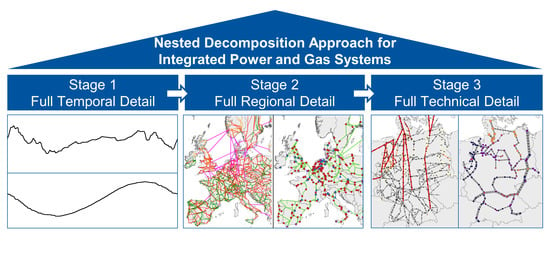Nested Decomposition Approach for Dispatch Optimization of Large-Scale, Integrated Electricity, Methane and Hydrogen Infrastructures
Abstract
1. Introduction
1.1. Motivation
- Integrated modeling of multi-energy-infrastructures
- Consideration of a full year in at least hourly resolution
- Consideration of transmission systems in nodal resolution and the physical laws determining their power flows (electricity and gas flows)
- Application on real, large-scale energy systems
1.2. Literature Review on Dispatch Models for IEI
| References | Name | Model Class | Energy Carrier | Physics Power/Gas | Spatial Scope/Resolution | Temporal Scope/Resolution |
|---|---|---|---|---|---|---|
| [12] | Riepin et al. | Market | electricity, gas | network flow | Europe/country | year/1 h |
| [13] | Baumann | Market | electricity, gas | network flow | Europe/country | year/1 h (1 d) |
| [14,15] | Quelhas et al. | Market | electricity, gas, coal | network flow | USA/US regions | year/1 h |
| [16] | PLEXOS | Market | electricity, gas, heat | DC/network flow | USA/Europe/nodal | year/(≥1 min) |
| [21] | PRIMES | Invest | total energy system | DC/network flow | Europe /country | years/1 h (type) |
| [23,24] | REMix | Invest | total energy system | DC/network flow | Germany/regions | years/1 h |
| [25] | PyPSA | Invest | total energy system | DC/network flow | Europe/nodal | years/1 h |
| [26] | Nemec-Begluk | Invest | electricity, gas, heat | DC/network flow | Austria/nodal | year/1 h |
| [41,42] | Geidl | OPGF | all (modular) | AC/steady state | 3 × 3 test/nodal | day/1 h |
| [38] | Correa-P. et al. | OPGF | electricity, gas | DC/steady state | 24 × 20 test/nodal | day/1 h |
| [30] | Sun et al. | OPGF | electricity, gas | AC/q.-steady state | 24 × 20 test/nodal | day/1 h |
| [40] | Schwele et al. | OPGF | electricity, gas, heat | DC/steady state | 24 × 12 × 3 test/nodal | day/1 h |
| [8,33] | SAInt, Pambour | OPGF | electricity, gas | AC/transient | 30 × 25 test/nodal | day/1 h |
| [36] | Chaudry et al. | OPGF | electricity, gas | DC/steady state | 16 × 168 UK/nodal | day/1 h |
| [29] | Löhr et al. | OPGF | electricity, gas | DC/q.-steady state | 542 × 524 GER/nodal | day/1 h |
1.3. Contribution and Paper Organization
2. Nested Decomposition Approach
2.1. Integrated Dispatch Optimization Problem
- Node balance equation in each infrastructure (A1)
- DC power flow Equations (A3) and (A5)
- Electrical transmission loss Equation (non-linear) (A6)
- Steady-state pressure loss Equation (non-linear) (A7)
- Linepack Equations (non-linear) (A8)–(A11)
- Horsepower equations for losses in compression (non-linear) (A16)–(A18)
- Conversion continuity Equation (A19)
- Storage continuity Equation (A20)
- Technical operation limits in Equations (A2), (A4), (A12)–(A15), (A21)–(A24)
2.2. Analysis of Complexity Drivers
2.3. Overview on Model Reduction and Decomposition Techniques
2.4. Applied Model Reduction and Decomposition Techniques
2.5. Stage 1: Storage Level Optimization in Full Temporal Detail
2.6. Stage 2: Simplified Dispatch Optimization in Full Spatial Detail
2.7. Stage 3: Dispatch Optimization in Full Technical Detail
3. Application of the Approach
3.1. Scenario Description
3.2. Analysis of Dispatch Costs
3.3. Analysis of Seasonal Dispatch
3.4. European Infrastructure Analysis
3.5. Snapshot Analysis for Germany
4. Conclusions
- Integrated energy system modeling
- Scalability to full-year modeling in hourly resolution
- Applicability to large-scale energy system model in nodal resolution
- Detailed modeling of non-linear physical laws:
- o
- Electric power flows with DC approximation and electric losses
- o
- Quasi-steady state methane and hydrogen flows and compression losses
- Loss of optimality guarantee due to successive decomposition, but a near-optimal solution may be sufficient for the purpose of energy system analysis. The optimality gap cannot be quantified due to the complexity of the problem. However, this gap can be rationally estimated as small as important interactions are taken into account by the applied problem-specific decomposition.
- Reduced spatial scope for high detailed technical analysis, however, the achievable regional scope can still be classified as large-scale compared to other applications in literature.
- Remaining model simplifications like DC power flow, quasi-steady-state gas flow, a rough estimation of contingencies and the neglect of non-linear operating constraints, but they appear to be largely justified in long-term system planning.
- No inherent consideration of uncertainties, but this can be addressed through scenario analysis.
- The presented approach will have the following use cases and enhancements:
- Annual dispatch analysis of IEI including cost and emissions analysis taking into account technical constraints and losses of energy transmission and conversion.
- Application in cost-benefit analyses to assess system design principles or single infrastructure projects such as HVDC-links, pipelines or electrolyzers. For this purpose, a delta consideration of two scenarios can be performed.
- Planned model enhancements include the integration of district heating infrastructures and additional linearized dispatch constraints of plants.
Author Contributions
Funding
Data Availability Statement
Acknowledgments
Conflicts of Interest
Nomenclature
| Quantities | |||
| Incident branches | Time steps | ||
| Branches | Consumers | ||
| Storages | Regions | ||
| Energy carrier | Subperiods | ||
| Nodes | Incident feed-in and feed-out | ||
| Supplies | |||
| Variables | |||
| Linepack | Phase angle | ||
| Electrical or thermal power flow | Phase angle shift | ||
| Storage level | Squared pressure | ||
| Parameters | |||
| Annuity factor | Temperature | ||
| Cost | Operational voltage | ||
| Pipeline diameter | Impedance | ||
| Specific emissions | Efficiency | ||
| Lower heating value | Isentropic exponent | ||
| Compressibility factor | Pipe friction coefficient | ||
| Pipeline length | ρ | Density | |
| Resistance | Maximal pressure reduction ratio | ||
| Specific gas constant | Maximal pressure rise ration | ||
| Indexes | |||
| Alternating current | Inflow | ||
| Methane | Installed capacity | ||
| Carbon dioxide | Losses | ||
| Compressor | Medium | ||
| Direct current | Maximum | ||
| Dispatchable | Minimum | ||
| Driving | Standard condition | ||
| Demand side response | Outflow | ||
| Electricity | Phase-shifting transformer () | ||
| Energy not served | Pressure regulator | ||
| Fuel costs | Index for time steps | ||
| Gas (pipelines) | Transformer | ||
| Hydrogen | Index for sub periods | ||
| Index for nodes and plants | Indexes for energy carrier | ||
| Index for branches from node to and node | In-feeding | ||
| Intermittent | − | Out-feeding | |
| Isentropic | |||
Appendix A. Integrated Dispatch Optimization Problem
- Electricity with subsets and ,
- Gases with subsets hydrogen and methane
Appendix A.1. Power System
Appendix A.2. Gas Systems
Appendix A.3. Conversion Plants
Appendix A.4. Storages
Appendix A.5. Other Feed-In and Feed-Out
Appendix A.6. Objective
References
- European Commission. The European Green Deal. Brussels. 2019. Available online: https://eur-lex.europa.eu/legal-content/EN/TXT/?qid=1576150542719&uri=COM%3A2019%3A640%3AFIN (accessed on 20 February 2022).
- European Commission. Powering a Climate-Neutral Economy: An EU Strategy for Energy System Integration. Brussels. 2020. Available online: https://ec.europa.eu/commission/presscorner/detail/en/ip_20_1259 (accessed on 20 February 2022).
- Kondziella, H.; Bruckner, T. Flexibility requirements of renewable energy based electricity systems—A review of research results and methodologies. Renew. Sustain. Energy Rev. 2016, 53, 10–22. [Google Scholar] [CrossRef]
- Sterner, M. Bioenergy and Renewable Power Methane in Integrated 100% Renewable Energy Systems; Kassel University Press: Kassel, Germany, 2009; Volume 14. [Google Scholar]
- Guidehouse. Extending the European Hydrogen Backbone—A European Hydrogen Infrastructure Vision Covering 21 Countries. Utrecht, The Netherlands. 2021. Available online: https://gasforclimate2050.eu/sdm_downloads/extending-the-european-hydrogen-backbone/ (accessed on 20 February 2022).
- ENTSO-E. 2nd ENTSO-E Guideline for Cost Benefit Analysis of Grid Development Projects. 2018. Available online: https://tyndp.entsoe.eu/cba (accessed on 20 February 2022).
- ENTSOG. 2nd ENTSOG Methodology for Cost-Benefit Analysis of Gas Infrastructure Projects. 2018. Available online: https://www.entsog.eu/methodologies-and-modelling#2nd-cba-methodology (accessed on 20 February 2022).
- Pambour, K.A. Modelling, Simulation and Analysis of Security of Supply Scenarios in Integrated Gas and Electricity Transmission Networks. Ph.D. Thesis, University of Groningen, Groningen, The Netherlands, 2018. [Google Scholar]
- Pfenninger, S.; Hawkes, A.; Keirstead, J. Energy systems modeling for twenty-first century energy challenges. Renew. Sustain. Energy Rev. 2014, 33, 74–86. [Google Scholar] [CrossRef]
- Frysztacki, M.M.; Hörsch, J.; Hagenmeyer, V.; Brown, T. The strong effect of network resolution on electricity system models with high shares of wind and solar. Appl. Energy 2021, 291, 116726. [Google Scholar] [CrossRef]
- Nolden, C.; Schönfelder, M.; Eßer-Frey, A.; Bertsch, V.; Fichtner, W. Network constraints in techno-economic energy system models: Towards more accurate modeling of power flows in long-term energy system models. Energy Syst. 2013, 4, 267–287. [Google Scholar] [CrossRef][Green Version]
- Riepin, I.; Möbius, T.; Müsgens, F. Integrated Electricity and Gas Market Modeling—Effects of Gas Demand Uncertainty. In Proceedings of the 15th International Conference on the European Energy Market (EEM), Lodz, Poland, 27–29 June 2018. [Google Scholar] [CrossRef]
- Baumann, C. Simulation der europäischen Märkte für Erdgas und Strom. Aachener Beiträge zur Energieversorgung. Ph.D. Thesis, RWTH Aachen University, Aachen, Germany, 2015. [Google Scholar]
- Quelhas, A.; Gil, E.; McCalley, J.D.; Ryan, S.M. A Multiperiod Generalized Network Flow Model of the U.S. Integrated Energy System: Part I—Model Description. IEEE Trans. Power Syst. 2007, 22, 829–836. [Google Scholar] [CrossRef]
- Quelhas, A.; Gil, E.; McCalley, J.D.; Ryan, S.M. A Multiperiod Generalized Network Flow Model of the U.S. Integrated Energy System: Part II—Simulation Results. IEEE Trans. Power Syst. 2007, 22, 837–844. [Google Scholar] [CrossRef]
- Deane, J.P.; Ciaráin, M.Ó.; Gallachóir, B.P.Ó. An integrated gas and electricity model of the EU energy system to examine supply interruptions. Appl. Energy 2017, 193, 479–490. [Google Scholar] [CrossRef]
- Lemaréchal, C. Lagrangian Relaxation, Computational Combinatorial Optimization, Optimal or Provably Near-Optimal Solutions. In Lecture Notes in Computer Science; Springer: Berlin, Germany, 2000; pp. 112–156. [Google Scholar]
- Deutsche Energie-Agentur GmbH (DENA). DENA-Leitstudie Integrierte Energiewende: Impulse für die Gestaltung des Energiesystems bis 2050. 2018. Available online: https://www.dena.de/integrierte-energiewende/ (accessed on 20 February 2022).
- Henning, H.-M.; Palzer, A. Energiesystem Deutschland 2050: Sektor- und Energieträgerübergreifende, modellbasierte, ganzheitliche Untersuchung zur langfristigen Reduktion energie-bedingter CO2-Emissionen durch Energieeffizienz und den Einsatz Erneuerbarer Energien; Fraunhofer ISE: Freiburg, Germany, 2013. [Google Scholar]
- Markewitz, P.; Stein, G. Das IKARUS-Projekt: Energietechnische Perspektiven für Deutschland: Abschlussbericht des Projektes IKARUS; Forschungszentrum Jülich: Jülich, Germany, 2003. [Google Scholar]
- E3MLab. Primes Model Version 6 2016–2017, Detailed Model Description; E3MLab: Athens, Grecee, 2017. [Google Scholar]
- Loulou, R.; Lehtilä, A.; Kanudia, A.; Remme, U.; Goldstein, G. Documentation for the TIMES Model; ETSAP: Stuttgart, Germany, 2021. [Google Scholar]
- Gils, H.C.; Scholz, Y.; Pregger, T.; Luca de Tena, D.; Heide, D. Integrated modelling of variable renewable energy-based power supply in Europe. Energy 2017, 123, 173–188. [Google Scholar] [CrossRef]
- Fette, M.; Brandstätt, C.; Gils, H.C.; Gardian, H.; Pregger, T.; Schaffert, J.; Tali, E.; Brücken, N. Multi Sektor Kopplung: Modellbasierte Analyse der Integration erneuerbarer Stromerzeugung durch die Kopplung der Stromversorgung mit dem Wärme, Gas- und Verkehrssektor—Endbericht. 2020. Available online: https://elib.dlr.de/135971/ (accessed on 20 February 2022).
- Brown, T.; Hörsch, J.; Schlachtenberger, D. PyPSA: Python for Power System Analysis. J. Open Res. Softw. 2018, 6, 4. [Google Scholar] [CrossRef]
- Nemec-Begluk, S. Modeling and Optimization of Multi-Energy Systems and the Future Role of Storage and Coupling Technologies. Ph.D. Thesis, TU Wien, Vienna, Austria, 2020. [Google Scholar]
- Purchala, K. Modeling and Analysis of Techno-Economic Interactions in Meshed High Voltage Grids Exhibiting Congestion. Ph.D. Thesis, University of Leuven, Leuven, Belgium, 2005. [Google Scholar]
- Mischner, J.; Fasold, H.G.; Heymer, J. gas2energy.net. Systemplanerische Grundlagen der Gasversorgung; Deutscher Industrieverlag: München, Germany, 2015. [Google Scholar]
- Löhr, L.; Houben, R.; Moser, A. Optimal power and gas flow for large-scale transmission systems. Electr. Power Syst. Res. 2020, 189, 106724. [Google Scholar] [CrossRef]
- Sun, G.; Chen, S.; Wei, Z.; Chen, S. Multi-period integrated natural gas and electric power system probabilistic optimal power flow incorporating power-to-gas units. J. Mod. Power Syst. Clean Energy 2017, 5, 412–423. [Google Scholar] [CrossRef]
- Ordoudis, C.; Pinson, P.; Morales, J.M. An integrated market for electricity and natural gas systems with stochastic power producers. Eur. J. Oper. Res. 2019, 272, 642–654. [Google Scholar] [CrossRef]
- Schwele, A.; Ordoudis, C.; Kazempour, J.; Pinson, P. Coordination of Power and Natural Gas Systems: Convexification Approaches for Linepack Modeling. In Proceedings of the IEEE PowerTech, Milan, Italy, 23–27 June 2019. [Google Scholar] [CrossRef]
- Pambour, K.A.; Erdener, B.C.; Bolado-Lavin, R.; Dijkema, G.P.J. SAInt—A novel quasi-dynamic model for assessing security of supply in coupled gas and electricity transmission networks. Appl. Energy 2017, 203, 829–857. [Google Scholar] [CrossRef]
- An, S.; Li, Q.; Gedra, T.W. Natural gas and electricity optimal power flow. In Proceedings of the IEEE/PES Transmission and Distribution Conference and Exposition, Dallas, TX, USA, 7–12 September 2003. [Google Scholar] [CrossRef]
- Urbina, M.; Li, Z. A Combined Model for Analyzing the Interdependency of Electrical and Gas Systems. In Proceedings of the IEEE-39, North American Power Symposium, Las Cruces, NM, USA, 30 September–2 November 2007. [Google Scholar] [CrossRef]
- Chaudry, M.; Jenkins, N.; Strbac, G. Multi-time period combined gas and electricity network optimization. Electr. Power Syst. Res. 2008, 78, 1265–1279. [Google Scholar] [CrossRef]
- Chiang, N.-Y.; Zavala, V.M. Large-scale optimal control of interconnected natural gas and electrical transmission systems. Appl. Energy 2016, 168, 226–235. [Google Scholar] [CrossRef]
- Correa-Posada, C.; Sanchez-Martin, P.; Lumbreras, S. Security-constrained model for integrated power and natural-gas system. J. Mod. Power Syst. Clean Energy 2017, 5, 326–336. [Google Scholar] [CrossRef]
- Ojeda-Esteybar, D.M.; Rubio-Barros, R.G.; Vargas, A. Integrated operational planning of hydrothermal power and natural gas systems with large scale storage. J. Mod. Power Syst. Clean Energy 2017, 5, 299–313. [Google Scholar] [CrossRef]
- Schwele, A.; Arrigo, A.; Vervaeren, C.; Kazempour, J.; Vallée, F. Coordination of Electricity, Heat, and Natural Gas Systems Accounting for Network Flexibility. Electr. Power Syst. Res. 2020, 189, 106776. [Google Scholar] [CrossRef]
- Geidl, M.; Koeppel, G.; Favre-Perrod, P.; Klöckl, B.; Andersson, G.; Fröhlich, K. The Energy Hub—A Powerful Concept for Future Energy Systems. In Proceedings of the Third Annual Carnegie Mellon Conference on the Electricity Industry, Pittsburgh, PA, USA, 13–14 March 2007. [Google Scholar]
- Geidl, M. Integrated Modeling and Optimization of Multi-Carrier Energy Systems. Ph.D. Thesis, ETH Zürich, Zürich, Switzerland, 2007. [Google Scholar] [CrossRef]
- Kotzur, L.; Nolting, L.; Hoffmann, M.; Groß, T.; Smolenko, A.; Priesmann, J.; Busing, H.; Beer, R.; Kullmann, F.; Singh, B.; et al. A modeler’s guide to handle complexity in energy systems optimization. Adv. Appl. Energy 2021, 4, 100063. [Google Scholar] [CrossRef]
- Scholz, Y.; Fuchs, B.; Borggrefe, F.; Cao, K.K.; Wetzel, M.; von Krbek, K.; Cebulla, F.; Gils, H.C.; Fiand, F.; Bussieck, M.; et al. Speeding up Energy System Models—A Best Practice Guide. 2020. Available online: https://elib.dlr.de/135507/ (accessed on 20 February 2022).
- Traub, J.F.; Woniakowski, H. Complexity of linear programming. Oper. Res. Lett. 1982, 1, 59–62. [Google Scholar] [CrossRef][Green Version]
- Cao, K.; von Krbel, K.; Wetzel, M.; Cebulla, F.; Schreck, S. Classification and Evaluation of Concepts for Improving the Performance of Applied Energy System Optimization Models. Energies 2019, 12, 4656. [Google Scholar] [CrossRef]
- Ward, J.B. Equivalent Circuits for Power Flow Studies. AIEE Trans. Power Appl. Syst. 1949, 68, 373–382. [Google Scholar] [CrossRef]
- Dantzig, G.B.; Wolfe, P. Decomposition Principle for Linear Programs. Oper. Res. 1960, 8, 101–111. [Google Scholar] [CrossRef]
- Benders, J.F. Partitioning Procedures for Solving Mixed-Variable Programming Problems. Numer. Math. 1962, 4, 238–252. [Google Scholar] [CrossRef]
- ENTSO-E; ENTSOG. TYNDP 2022 Draft Scenario Report, Brussels. 2021. Available online: https://2022.entsos-tyndp-scenarios.eu/ (accessed on 20 February 2022).
- ENTSO-E. Grid Map. 2021. Available online: https://www.entsoe.eu/data/map/ (accessed on 20 February 2022).
- ENTOG. Transparency Platform. 2021. Available online: https://transparency.entsog.eu/#/map (accessed on 20 February 2022).
- Rövekamp, J. Transportnetzberechnung zur Feststellung der Erdgasversorgungssicherheit in Deutschland unter Regulatorischem Einfluss. Ph.D. Thesis, TU Clausthal, Clausthal, Germany, 2014. [Google Scholar]
- Gils, H.C. Balancing of Intermittent Renewable Power Generation by Demand Response and Thermal Energy Storage. Ph.D. Thesis, Universität Stuttgart, Stuttgart, Germany, 2015. [Google Scholar] [CrossRef]
- Hörsch, J.; Ronellenfitsch, H.; Witthaut, D.; Brown, T. Linear optimal power flow using cycle flows. Electr. Power Syst. Res. 2018, 158, 126–135. [Google Scholar] [CrossRef]
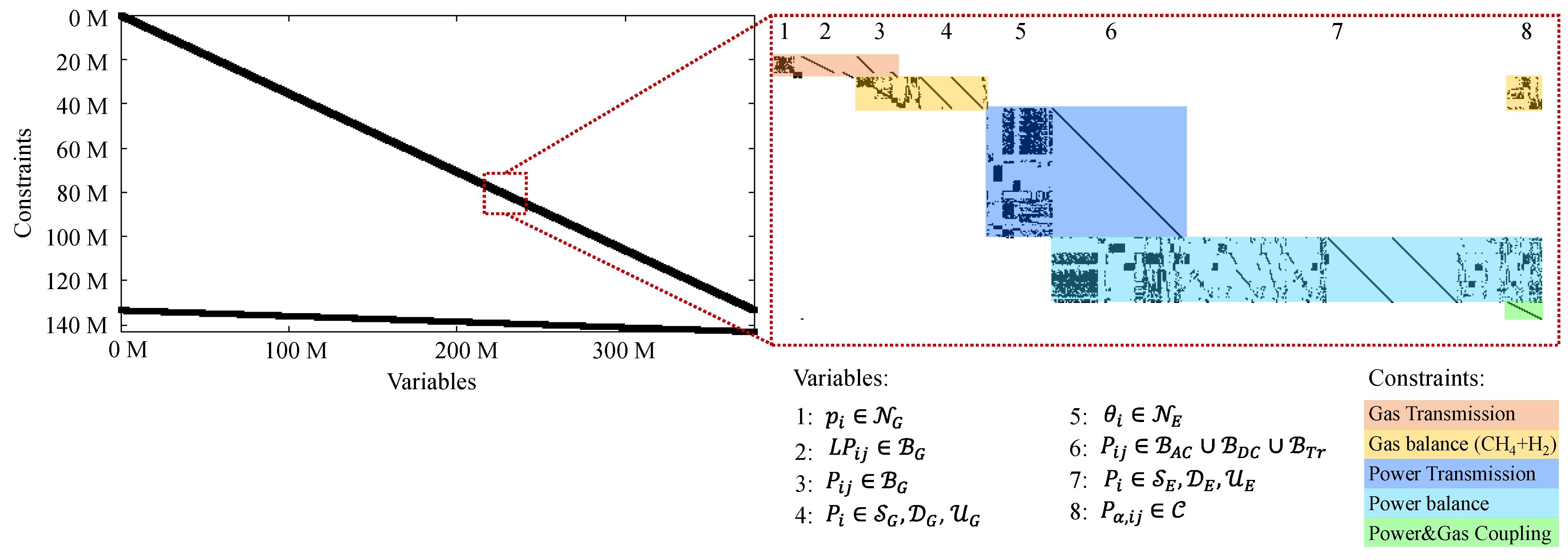
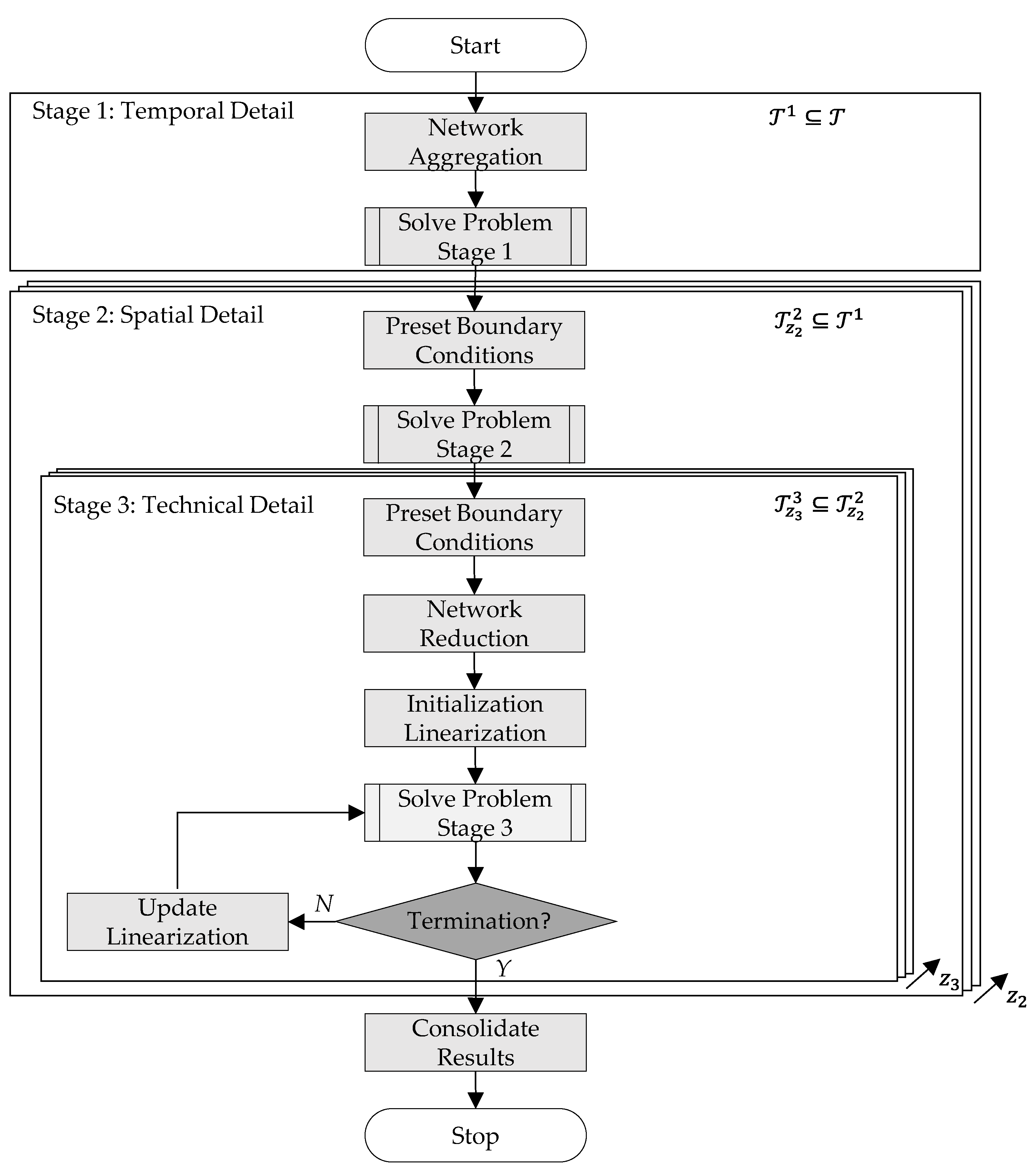
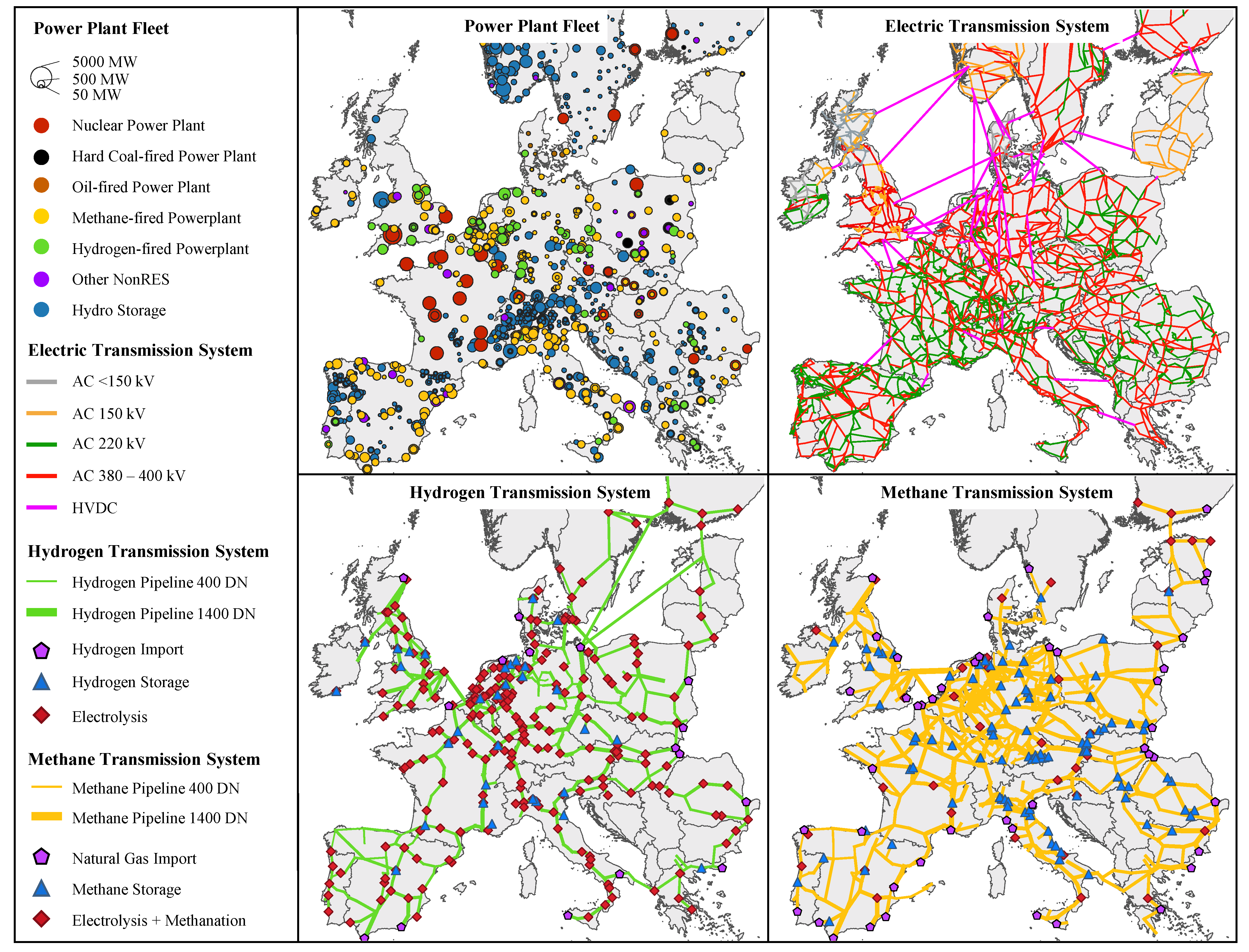

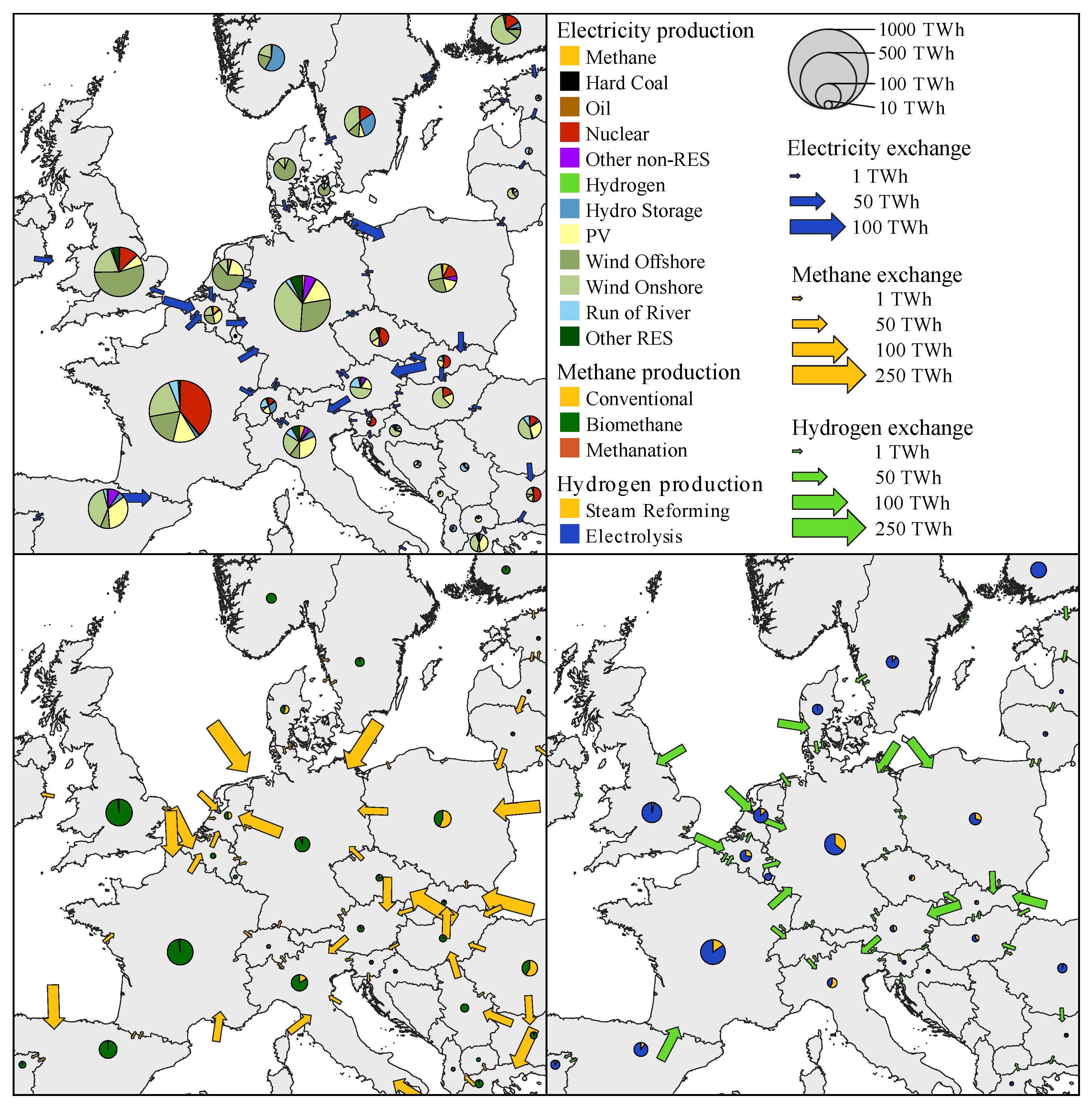
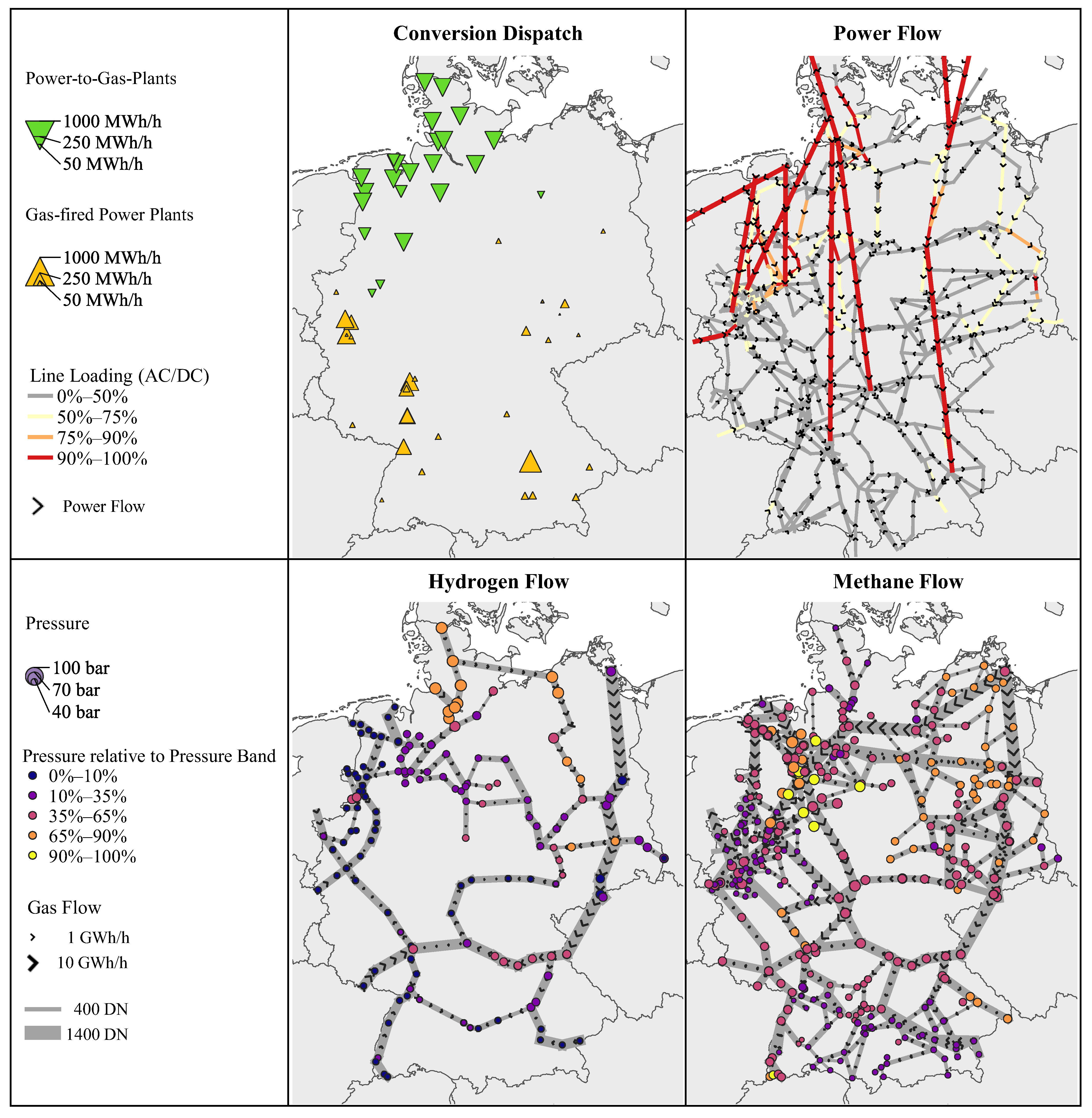
| Dimension | Slicing | Aggregation |
|---|---|---|
| Time |
|
|
| Space |
|
|
| Technology |
|
|
| Dimension | Stage 1 | Stage 2 | Stage 3 |
|---|---|---|---|
| Time |
|
| |
| Space |
|
| |
| Technology |
|
|
| Type | Costs |
|---|---|
| Nuclear | 1.7 €/MWhth |
| Hard Coal | 6.9 €/MWhth |
| Oil | 34.6 €/MWhth |
| Biomethane | 61.0 €/MWhth |
| Natural Gas imports | 14.7 €/MWhth |
| Green Hydrogen Imports | 57.9 €/MWhth |
| Demand Side Response | 1000 €/MWhel |
| Value of Lost Load Electricity | 5000 €/MWhel |
| Value of Lost Load Gases | 1000 €/MWhth |
| CO2 | 123 €/tCO2 |
| Scenario 2040 | Europe | Germany |
|---|---|---|
| Final Energy Demand Electricity | 3994 TWh/a | 718 TWh/a |
| Final Energy Demand Methane | 2439 TWh/a | 435 TWh/a |
| Final Energy Demand Hydrogen | 1391 TWh/a | 345 TWh/a |
| Installed Capacity Nuclear | 120 GW | 0 GW |
| Installed Capacity Hard Coal | 3 GW | 0 GW |
| Installed Capacity Methane | 233 GW | 35 GW |
| Installed Capacity Hydrogen | 0.5 GW | 0 GW |
| Installed Capacity Oil | 8 GW | 3 GW |
| Installed Capacity Other Non-RES | 38 GW | 9 GW |
| Installed Capacity PV | 828 GW | 124 GW |
| Installed Capacity Wind Onshore | 630 GW | 117 GW |
| Installed Capacity Wind Offshore | 341 GW | 52 GW |
| Installed Capacity Run of River | 58 GW | 5 GW |
| Installed Capacity Hydro Storage | 190 GW | 10 GW |
| Installed Capacity Other RES | 35 GW | 9 GW |
| Installed Capacity Battery | 40 GW | 7 GW |
| Installed Capacity Electrolysis | 160 GW | 20 GW |
| Installed Capacity Methanation | 10 GW | 3 GW |
| Installed Capacity DSR | 18 GW | 3 GW |
| Biomethane Potential | 749 TWh/a | 51 TWh/a |
| Conventional Methane Production | 106 TWh/a | 0 TWh/a |
| Source | Natural Gas | Hydrogen |
|---|---|---|
| Russia | 2044 TWh/a | 216 TWh/a |
| Norway | 818 TWh/a | 244 TWh/a |
| North Africa | 337 TWh/a | 291 TWh/a |
| South East | 514 TWh/a | 0 TWh/a |
| LNG | 1515 TWh/a | - |
| Type | Costs |
|---|---|
| Nuclear Power Plants | 3.07 bn €/a |
| Hard Coal-fired Power Plants 1 | 0.06 bn €/a |
| Oil Power Plants 1 | 0.02 bn €/a |
| Biomass Power Plants | 9.90 bn €/a |
| Natural Gas Imports 1 | 73.12 bn €/a |
| Natural Gas Conventional Production 1 | 4.19 bn €/a |
| Biomethane Production | 45.60 bn €/a |
| Green Hydrogen Imports | 37.35 bn €/a |
| Demand Side Response | 0.66 bn €/a |
| Value of Lost Load Electricity | 0.98 bn €/a |
| Value of Lost Load Gases | 0.00 bn €/a |
| SUM | 147.97 bn €/a |
Publisher’s Note: MDPI stays neutral with regard to jurisdictional claims in published maps and institutional affiliations. |
© 2022 by the authors. Licensee MDPI, Basel, Switzerland. This article is an open access article distributed under the terms and conditions of the Creative Commons Attribution (CC BY) license (https://creativecommons.org/licenses/by/4.0/).
Share and Cite
Löhr, L.; Houben, R.; Guntermann, C.; Moser, A. Nested Decomposition Approach for Dispatch Optimization of Large-Scale, Integrated Electricity, Methane and Hydrogen Infrastructures. Energies 2022, 15, 2716. https://doi.org/10.3390/en15082716
Löhr L, Houben R, Guntermann C, Moser A. Nested Decomposition Approach for Dispatch Optimization of Large-Scale, Integrated Electricity, Methane and Hydrogen Infrastructures. Energies. 2022; 15(8):2716. https://doi.org/10.3390/en15082716
Chicago/Turabian StyleLöhr, Lukas, Raphael Houben, Carolin Guntermann, and Albert Moser. 2022. "Nested Decomposition Approach for Dispatch Optimization of Large-Scale, Integrated Electricity, Methane and Hydrogen Infrastructures" Energies 15, no. 8: 2716. https://doi.org/10.3390/en15082716
APA StyleLöhr, L., Houben, R., Guntermann, C., & Moser, A. (2022). Nested Decomposition Approach for Dispatch Optimization of Large-Scale, Integrated Electricity, Methane and Hydrogen Infrastructures. Energies, 15(8), 2716. https://doi.org/10.3390/en15082716





